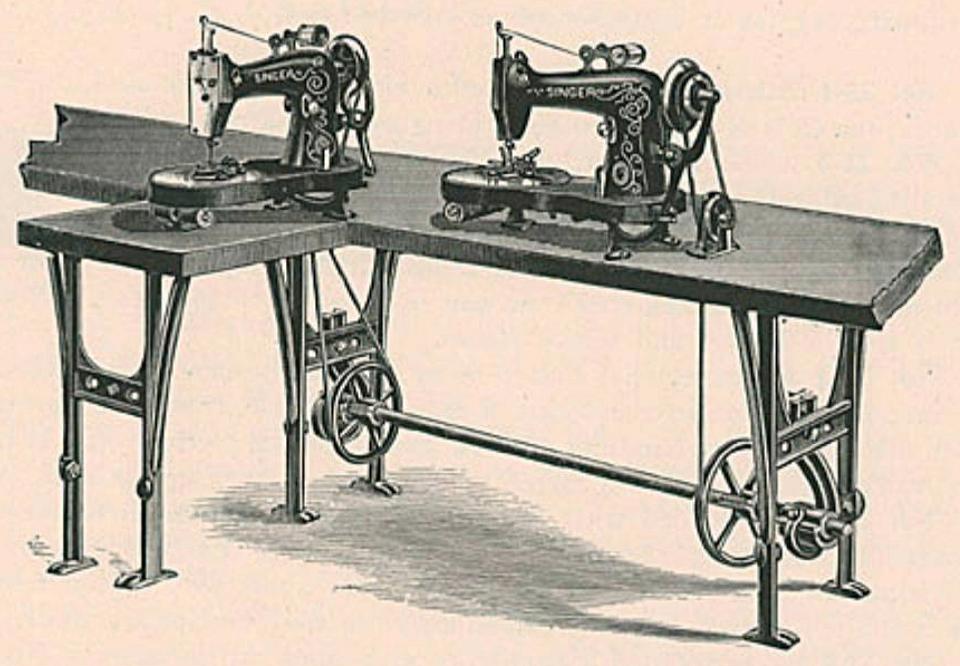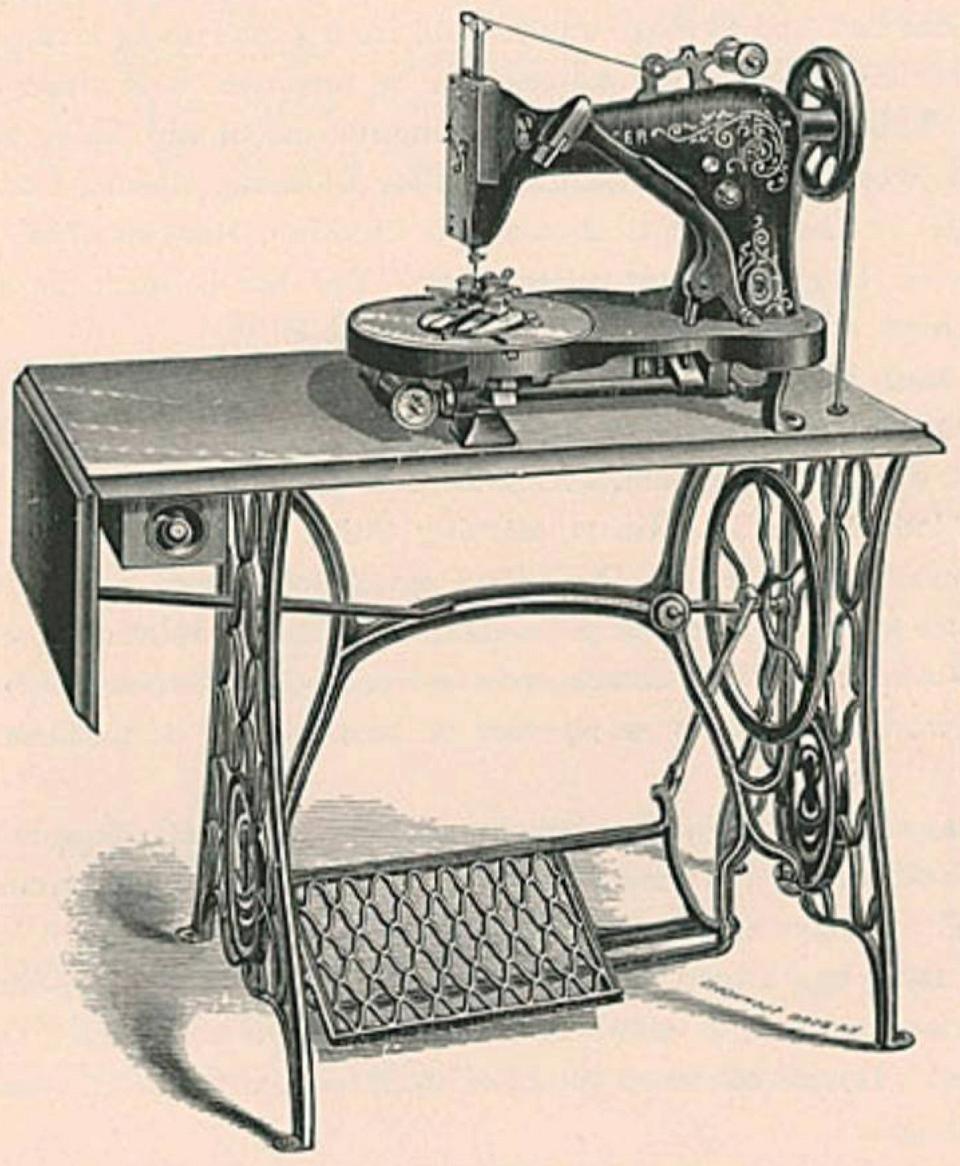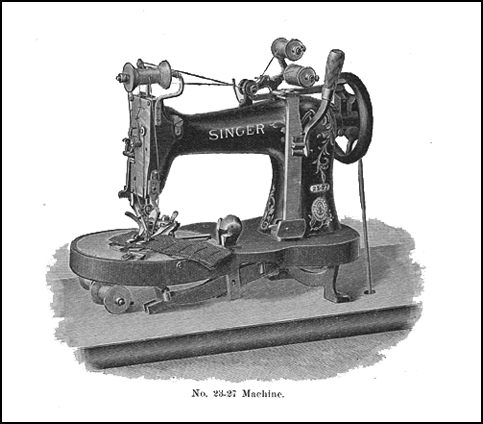Class 23.
FOR rapidly making Button-holes having the appearance and strength of the best hand work, the machines of Class 23 are unequaled.
They work button-holes with an equal perfection of finish on any class or thickness of fabric, making a “purl” stitch on the finished side of the goods.
The button-holes are of the usual shape and the machines can be fitted to make them of any length, not exceeding 2 1/2 inches, either with or without an eyelet-end, with a straight or a taper bar, or without bar.
The hole is cut in textiles by one blow of the knife. It can be made either before or after the formation of the stitch, as best adapted to the texture of the fabric. Means are provided for spreading the button-hole before working it.
The mechanism is simple, durable and can be easily operated either by foot power or by mechanical power at high speed.
The work is held, face down, in a convenient clamping device which secures absolute accuracy; the feed carries this clamp in exact relation to the speed of the stitch-forming mechanism.
The stitch-forming mechanism consists of loopers and spreaders under the work-plate; these lock together the threads from the upper and lower spools, and form a firm, hard “purl” stitch, a strengthening cord or gimp being laid along the edge of the button-hole and covered by the thread forming the stitch. By using an upper guide, a cord can be laid on the reverse side of the fabric, so that the button-hole will present the same appearance on both sides.
Either silk or cotton thread can be used, or silk upper and cotton lower thread. The length of the stitch and the distance between stitches are adjustable as desired. On closely woven fabrics the stitch can be firmly worked on extreme edge, making a “narrow bead," finely finished button-hole or it can be carried back | inch on face of fabric, as desired.
Each machine for cloth is provided with loopers for making the stitch with either a single or double thread; the former gives the exact appearance of hand work and uses less thread; the latter increases the strength and durability.
There are seventeen varieties of machines in this class for making buttonholes, but most of their parts are interchangeable, those that are special to the respective varieties consisting principally of “deflecting pieces" for forming the taper bar on various lengths of button-holes, feed-wheels for the same purpose, “sliding buttons" for straight barring and special parts for automatic stop-motion.
Five of these varieties are for making button-holes in leather and twelve for making button-holes in textiles. They are described as follows :
FOR LEATHER.
The machines for leather have no cutting' attachment, a hand punch being furnished for cutting the holes before working; they are extensively used in Boot and Shoe manufacture where great strength and finished appearance of product are essential.
Each of these machines can be furnished with feed-wheel to make any of the following lengths of button-holes, as ordered: 3/8, 1/2, 9/16, 5/8, 11/16, 3/4, 7/8, 1 inch, 1 1/8 inch.
No. 23-1 makes eyeleted button-holes without bar and is used on fine custom work, the ends of the button-holes being usually barred by hand.
No. 23-2 makes eyeleted button-holes having a taper bar. Deflecting pieces are used in the clamps to produce this form of bar, which is carried, in a diagonal direction, past the end of the button-hole a distance of one-eighth inch or more, as desired. In making button-holes having a taper bar it is not necessary to carry the thread and cord from one button-hole to the next. This form of bar is used on Ladies' and Misses' Shoes.
No. 23-3 makes eyleted button-holes without bar and is provided with Automatic Stop-motion at completion of each button-hole, thus securing uniform length, enabling quicker handling of work and increased production. It is used on fine work when the ends are barred by hand or by a barring machine.
No. 23-4 is provided with Automatic Stop-motion and makes eyeleted button-holes with a straight bar, having the appearance of being hand made. The thread is carried from one hole to the next, on the under side of the fabric, to which it and the gimp are usually tacked after the button-holes are made.
No. 23-5 makes eyeleted button-holes with taper bar the same as No. 23-2, but has Automatic Stop-motion, as described for No. 23-3.

MACHINE No. 23-4
ARRANGED IN PAIRS FOR POWER.
The above illustration shows the method of power table so as to secure the greatest production manufacture of Shoes, Over-gaiters, Leggins. etc. arranging two machines of button-holes in the on a These machines stop automatically upon the completion of a button-hole, so that an operator seated in a revolving chair can run both machines. By this method the time occupied by one machine in automatically stitching a buttonhole is utilized by the operator in changing the work and starting the other machine. More than 7,500 button-holes have been stitched in one day of ten hours on a pair of these machines arranged as shown above.

MACHINE No. 23-8
ON STAND FOR FOOT POWER.
FOR TEXTILES.
Twelve varieties of Class 23 are for making button-holes them for woolen goods and three especially for linen and cotton fabrics.
They are all suitable for either foot or mechanical power as follows:
No. 23-7 is especially adapted to operate a short needle using cotton thread on cotton or linen fabrics. By means of a peculiar looper and loop spreader for the under thread, a very short needle can be used for the upper thread. This is an obvious advantage in collar and cuff work requiring a formation of the stitch through several plies of material, because vibration of needle is avoided and a perfect stitch secured. This machine has no cutting attachment, and can be fitted to make any size of button-hole from 1/2 inch to 1 1/2 inch long, the hole having a very small eyelet suitable for this class of work and no bar.
No. 23-8 has cutting attachment and makes an eyeleted button-hole without bar; it can be fitted to make any length, from A inch to 14 inch, on any kind •of textile fabric. The cutting knives can be furnished with either a large or a small eye. This machine has the widest range of use of any, being employed on all classes of work in the manufacture of Fine Clothing, Cloaks, Ladies' Dresses of silk, cotton or linen. Suits, Costumes, Oil Clothing, Mackintoshes, Gossamers, Canvas Goods, Leggins, Over-gaiters, etc. The bar is made by hand or by special machine, after the formation of button-hole.
No. 23-9 has cutting attachment, and can be fitted to make eyeleted button-holes from 1/2 inch to 1 1/2 inch in length; it makes the taper bar on all lengths not exceeding 1 3/8 inch. It is used in the manufacture of the cheaper grades of Clothing, Ladies’ Waists, Bathing Suits, Cardigan Jackets, Oil Clothing, Mackintoshes, Gossamers, Overalls, Canvas Goods, etc.
No. 23-10 has Automatic Stop-motion at the completion of each buttonhole; in all other respects it corresponds to No. 23-8. It is used in manufacturing on fine work where a large number of button-holes of uniform length are required.
No. 23-11 has Straight Bar attachment and Automatic Stop-motion. It is used in manufacturing the cheaper classes of Mackintoshes, Gossamers, etc., and can be fitted to make eyeleted button-holes from 1/2 inch to 1 1/2 inch in length. No. 23-12 has Taper Bar attachment and Automatic Stop-motion. It is used in the manufacture of Men's Pants, Boys’ Jackets and Pants, Over-gaiters, Leggins, etc. It can be fitted to make eyeleted button-holes from 1/2 inch to 1 1/2 inch in length.
No. 23-13 makes Eyeless button-holes with a Taper Bar and has Automatic Stop-motion. It can be fitted for any length of button-hole from A inch to 1| inch, making the Taper Bar on all lengths not exceeding 1g inch. It is used in the manufacture of Collars and Cuffs, Ladies’ Shirt Waists, Wrappers, Silk Waists, -etc.
No. 23-14 has short needle for using cotton thread on linen and cotton fabrics, corresponding in its uses to No. 23-7, from which it only differs in having a cutting attachment.
No. 23-16 is for making all lengths of button-holes not exceeding 2 inches and is extensively used in Cloak manufacture. It has a cutting attachment and docs not make a bar.
No. 23-18 has short needle for using cotton thread on linen or cotton fabrics and is provided with Straight Barring attachment and Automatic Stop-motion. It has no cutting attachment, and is extensively used in Collar and Cuff manufacture.
No. 23-19 for button-holes 1/2 inch to 1 1/2 inch, and No. 23-20, for buttonholes from 1/2 to 2 inches long inclusive, have cutting attachment, and are also provided with straight barring attachment and a hand-tripping straight bar can be made at any instant in the formation of the button-hole.
These machines are used by button-hole manufacturers having a variety of lengths to make. They enable quick changes and the formation of any length, within the limits specified, thus largely increasing the output of this class of work.
FOR EYELETS (Purl Stitch).
Machine No. 23-15 is adapted for making Eyelets in Textiles or Leather; the eyelets are finished with a "purl" stitch that is unequaled for strength and finished appearance.
It is used in Shoe manufacture, in the manufacture of Clothing for the Navy and for work of a similar character; it is of the highest efficieney for finishing eyelet holes requiring this form of stitch.
FOR BARRING OR FINISHING SELVAGE ENDS.
Machine No. 23-17 is designed for barring or finishing, with the buttonhole stitch, the cut ends of binding after it is stitched on to a garment.
It is extensively used for this purpose in the manufacture of Corsets.
The following is lifted from John Langdon's Comprehensive Model List
| 23W (class) | Industrial | Vertical rotating sewing hook with stationary bobbin case mechanism at left of needle, for making the lock stitch. For shirts, shirt waists, wrappers, underwear, collars, cuffs, shoes, gloves, corsets, suspenders, infants' clothing, table cloths, etc. | 126x1, 126x3, 128x1, 128x2, 128x3, 128x4, 128x5. 128x6, 128x7, 128x11, 128x13 | |
| 23-1 | (Cancelled 07/38) | Industrial | For buttonholes 3/8" to 1 1/8" long in leather. Speed 1000. | 23x2 |
| 23W1 | (Cancelled 07/33) | |||
| 23-2 | Industrial | For buttonholes 3/8" to 1 1/8" long in leather. Speed 1000. Taper bar attachment. | 23x2 | |
| 23-3 | (Cancelled 07/33) | Industrial | For buttonholes 3/8" to 1 1/8" long in leather. Speed 1000; with automatic stop. | 23x2 |
| 23-4 | (Cancelled 07/38) | Industrial | For buttonholes 3/8" to 1 1/8" long in leather. Speed 1000; with straight barring attachment and automatic stop. | 23x2 |
| 23-5 | Industrial | For buttonholes 3/8" to 1 1/8" long in leather. Speed 1000; with taper barring attachment and automatic stop. | 23x2 | |
| 23W5 | (Cancelled 12/28) | |||
| 23-6 | Industrial | For eyeless buttonholes 3/8" to 1 1/8" | 23x2 | |
| 23W6 | (Cancelled 07/33) | |||
| 23-7 | Industrial | Short needle. For cotton thread on linen and cotton fabrics. Speed 1000. Speed 1000. | 23x3 | |
| 23W7 | (Cancelled 07/33) | |||
| 23-8 | (Cancelled 07/46) | Industrial | For buttonholes 1/2" to 1 1/2" long in cloth . With cutting attachment. Speed 1000. Singer suggested replacement 99W110 (cutafter). 99W130 (cut first). | 23x1 |
| 23-9 | (Cancelled 07/38) | Industrial | For buttonholes 1/2" to 1 1/2" long in cloth . With cutting and taper bar attachments. Speed 1000. | 23x1 |
| 23-10 | (Cancelled 07/33) | Industrial | For buttonholes 1/2" to 1 1/2" long in cloth . With cutting attachment and automatic stop. Speed 1000. | 23x1 |
| 23-11 | (Cancelled 07/33) | Industrial | For buttonholes 1/2" to 1 1/2" long in cloth . With cutting and straight barring attachments and automatic stop. Speed 1000. | 23x1 |
| 23-12 | (Cancelled 07/46) | Industrial | For buttonholes in cloth (eyelets, etc.). Singer suggested replacement 99W110 (cutafter). 99W130 (cut first). | |
| 23-13 to 23-28 | Industrial | For buttonholes in cloth (eyelets, etc.). | 23x1 | |
| 23-14 | Industrial | For buttonholes in cloth (eyelets, etc.). | 23x1 | |
| 23-15 | Industrial | For eyelets only, cloth or leather. | 23x1 | |
| 23-16 | Industrial | For buttonholes in cloth (eyelets, etc.). | 23x1 | |
| 23-17 | * | Industrial | For buttonholes in cloth (eyelets, etc.).
*(Cancelled 08/1909) |
23x1 |
| 23-18 | Industrial | For buttonholes in cloth (eyelets, etc.). | 23x1 | |
| 23-19 | Industrial | For buttonholes in cloth (eyelets, etc.). | 23x1 | |
| 23-20 | * | Industrial | For buttonholes in cloth (eyelets, etc.). Singer suggested replacement 99W112 (cutafter). 99W132 (cut first). *(Cancelled 07/46) | 23x1 |
| 23-21 | Industrial | For buttonholes in cloth (eyelets, etc.). | 23x1 | |
| 23-22 | Industrial | For buttonholes in cloth (eyelets, etc.). | 23x1 | |
| 23-23 | Industrial | For buttonholes in cloth (eyelets, etc.). | 23x1 | |
| 23-24 | Industrial | For buttonholes in cloth (eyelets, etc.). | 23x1 | |
| 23-25 | Industrial | For buttonholes in cloth (eyelets, etc.). | 23x1 | |
| 23-26 | Industrial | For buttonholes in cloth (eyelets, etc.). | 23x1 | |
23-27
|
Industrial | Cloth. With upper purling device for making double-faced buttonholes up to 1 1/2" long; with tension releaser for upper threads, and pressure cutting attachment - otherwise same as 23-26. | 23x1 | |
| 23-28 | Industrial | Cloth. For buttonholes 1/2" to 1 1/2" long. With cutting attachment. | ||
| 23-29 | * | Industrial | Cloth. For buttonholes 1/2" to 1 1/2" long; with cutting attachment. For very narrow bight, otherwise same as 23-8. *(Cancelled 09/1909 - "order 23-30") | |
| 23-30 | * | Industrial | Cloth. For imitation hand-made buttonholes 1/2" to 1 1/2" long; with cutting attachment. Long, narrow bight. Formerly 23SV23. Supercedes 23-29. *(Cancelled 07/38) |





